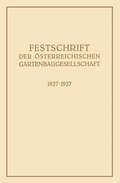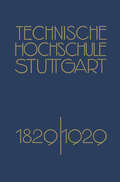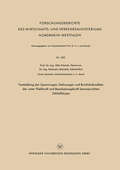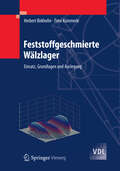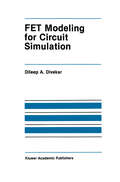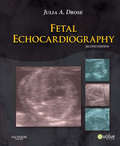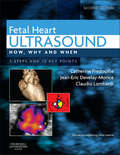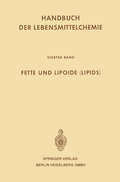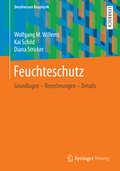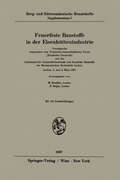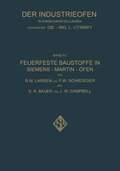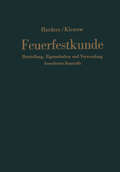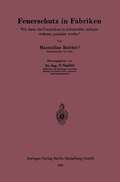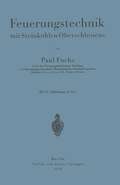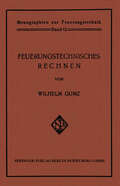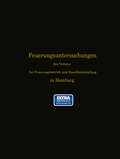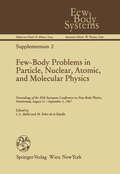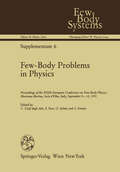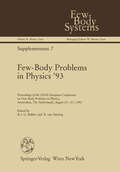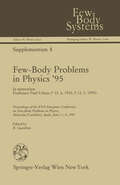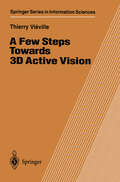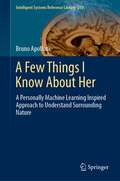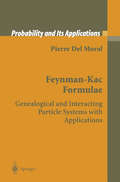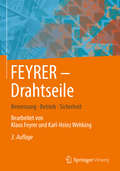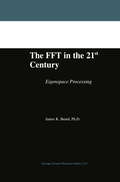- Table View
- List View
Festschrift der Österreichischen Gartenbaugesellschaft 1827-1927: (pdf)
by Österreichische GartenbaugesellschaftFestschrift der Technischen Hochschule Stuttgart: Zur Vollendung ihres Ersten Jahrhunderts 1829–1929
by Richard GrammelDieser Buchtitel ist Teil des Digitalisierungsprojekts Springer Book Archives mit Publikationen, die seit den Anfängen des Verlags von 1842 erschienen sind. Der Verlag stellt mit diesem Archiv Quellen für die historische wie auch die disziplingeschichtliche Forschung zur Verfügung, die jeweils im historischen Kontext betrachtet werden müssen. Dieser Titel erschien in der Zeit vor 1945 und wird daher in seiner zeittypischen politisch-ideologischen Ausrichtung vom Verlag nicht beworben.
Feststellung der Spannungen, Dehnungen und Bruchdrehzahlen der unter Fliehkraft und Bearbeitungskraft beanspruchten Schleifkörper (Forschungsberichte des Wirtschafts- und Verkehrsministeriums Nordrhein-Westfalen #232)
by Otto KienzleFeststoffgeschmierte Wälzlager: Einsatz, Grundlagen und Auslegung (VDI-Buch)
by Herbert Birkhofer Timo KümmerleIn dem Band werden Anwendungen für feststoffgeschmierte Wälzkontakte, etwa im Maschinenbau, in der Luft- und Raumfahrt, der Lebensmittelindustrie oder der Medizintechnik, vorgestellt. Ihre Potenziale und Grenzen werden analysiert und im Theorieteil systematisch hergeleitet. Ferner werden Prüfverfahren und Prüfeinrichtungen vorgestellt und Prüfergebnisse ausführlich erläutert. Ein Schwerpunkt ist die detaillierte Beschreibung der Gestaltungsfaktoren, die Lebensdauer und Lagerperformance von feststoffgeschmierten Wälzlagern beeinflussen.
FET Modeling for Circuit Simulation (The Springer International Series in Engineering and Computer Science #48)
by Dileep A. DivekarCircuit simulation is widely used for the design of circuits, both discrete and integrated. Device modeling is an impor tant aspect of circuit simulation since it is the link between the physical device and the sim ulate d device. Curren tly available circuit simulation programs provide a variety of built-in models. Many circuit designers use these built-in models whereas some incorporate new models in the circuit sim ulation programs. Understanding device modeling with particular emphasis on circuit simulation will be helpful in utilizing the built-in models more efficiently as well as in implementing new models. SPICE is used as a vehicle since it is the most widely used circuit sim ulation program. How ever, some issues are addressed which are not directly appli cable to SPICE but are applicable to circuit simulation in general. These discussions are useful for modifying SPICE and for understanding other simulation programs. The gen eric version 2G. 6 is used as a reference for SPICE, although numerous different versions exist with different modifications. This book describes field effect transistor models commonly used in a variety of circuit sim ulation pro grams. Understanding of the basic device physics and some familiarity with device modeling is assumed. Derivation of the model equations is not included. ( SPICE is a circuit sim ulation program available from EECS Industrial Support Office, 461 Cory Hall, University of Cali fornia, Berkeley, CA 94720. ) Acknowledgements I wish to express my gratitude to Valid Logic Systems, Inc.
Fetal Echocardiography - E-Book
by Julia A. DrosePerfect for both the novice learning to perform fetal echocardiography, as well as the expert needing more details of various anomalies, this comprehensive text/atlas covers everything you need to know. It incorporates a practical, multidisciplinary approach to diagnosis and management with contributors from various medical specialties. You’ll find complete information on physiology, detailed guidelines on how to perform a fetal echocardiogram, and highly illustrated coverage of various congenital heart abnormalities. Full-color images and coverage of the latest technologies keep you up to date with the latest in this fast-changing field.
Fetal Heart Ultrasound - E-Book: How, Why and When (How, Why and When)
by Catherine Fredouille Jean-Eric Develay-Morice Claudio LombardiFetal Heart Ultrasound, now in its second edition, has been written as a practical guide for the ultrasound examination of the fetal heart. The fetal heart is considered to be the most important and difficult part of a fetal examination. This book aims not only to clarify and simplify the approach to this examination, but also to define what a normal fetal heart should be, and underline just why this organ remains one of the best warning signs for fetal pathology. It will be useful to trainee and practicing ultrasonographers, ultrasound departments providing obstetric ultrasound services, and obstetricians, gynecologists, radiologists and midwives undertaking course in fetal ultrasonography. "Fetal Heart Ultrasound. How, Why and When ... could represent a supplement to other literature in the field, especially for trainees and ultrasonographers." Reviewed by Acta Obstetricia et Gynecologica Scandinavica,April 2015Illustrated with over 400 pathological and ultrasound diagrams and images Clarifies what makes the fetal heart normal, and what signs point to the pathologies that are important to diagnose Step-by-step guide to establishing different views, illustrating the correlations between technique and medical image, and outlining the pitfalls, obstacles and errors and how to recognize and avoid them Accompanying online ancillary material: original anatomical videoclips, ultrasound scans and self-assessment questions A chapter on first trimester ultrasonography covering the early detection, diagnosis and confirmation of fetal cardiac anomalies New videoclips relating to first trimester ultrasonography 50 scored online self-assessment questions with images
Fette und Lipoide (Handbuch der Lebensmittelchemie)
by Ludwig Acker H. -J Bindszus Josef SchormüllerFeuchteschutz: Grundlagen – Berechnungen – Details (Detailwissen Bauphysik)
by Wolfgang M. Willems Kai Schild Diana StrickerDer Feuchteschutz ist eines der zentralen Fachgebiete der Bauphysik und nimmt direkten Einfluss auf die konstruktive Ausgestaltung der meisten Bauelemente. Dieses Praxisbuch liefert dem Planer das notwendige Fachwissen für die entsprechende Anwendung, ohne dabei die Bezüge zum theoretischen Hintergrund auszulassen. Eine umfangreiche Sammlung an Baustoffkennwerten erleichtert die erforderlichen feuchteschutztechnischen Berechnungen enorm. Im Weiteren vermittelt das Buch detaillierte Kenntnisse unter anderem über den Feuchtetransport in Baustoffen, die Bildung von Feuchte im Bauteil sowie über rechnerische Nachweis- und weiterführende Simulationsverfahren. Darüber hinaus wird der für einen erfolgreichen Feuchteschutz geeignete Bauteilaufbau anhand zahlreicher Konstruktionsdetails dargestellt.
Feuerfeste Baustoffe in der Eisenhüttenindustrie: Vortragsreihe, veranstaltet vom Technisch-wissenschaftlichen Verein „Eisenhütte Österreich“ und der Lehrkanzel für Gesteinshüttenkunde und feuerfeste Baustoffe der Montanistischen Hochschule Leoben. Leoben, 2. und 3. März 1967 (Berg- und Hüttenmännische Monatshefte Supplementa #1)
by Herbert Trenkler Felix TrojerFeuerfeste Baustoffe in Siemens-Martin-Öfen
by B.M. Larsen F.W. Schroeder E.N. Bauer J.W. Campbell Phil Walter StegerDieser Buchtitel ist Teil des Digitalisierungsprojekts Springer Book Archives mit Publikationen, die seit den Anfängen des Verlags von 1842 erschienen sind. Der Verlag stellt mit diesem Archiv Quellen für die historische wie auch die disziplingeschichtliche Forschung zur Verfügung, die jeweils im historischen Kontext betrachtet werden müssen. Dieser Titel erschien in der Zeit vor 1945 und wird daher in seiner zeittypischen politisch-ideologischen Ausrichtung vom Verlag nicht beworben.
Feuerfestkunde: Herstellung, Eigenschaften und Verwendung feuerfester Baustoffe
by Friedrich Harders Sigismund KienowFeuerschutz in Fabriken: Wie kann der Feuerschutz in industriellen Anlagen wirksam gestaltet werden?
by Maximilian Reichel Otto SanderDieser Buchtitel ist Teil des Digitalisierungsprojekts Springer Book Archives mit Publikationen, die seit den Anfängen des Verlags von 1842 erschienen sind. Der Verlag stellt mit diesem Archiv Quellen für die historische wie auch die disziplingeschichtliche Forschung zur Verfügung, die jeweils im historischen Kontext betrachtet werden müssen. Dieser Titel erschien in der Zeit vor 1945 und wird daher in seiner zeittypischen politisch-ideologischen Ausrichtung vom Verlag nicht beworben.
Feuerungstechnik mit Steinkohlen Oberschlesiens
by Paul FuchsDieser Buchtitel ist Teil des Digitalisierungsprojekts Springer Book Archives mit Publikationen, die seit den Anfängen des Verlags von 1842 erschienen sind. Der Verlag stellt mit diesem Archiv Quellen für die historische wie auch die disziplingeschichtliche Forschung zur Verfügung, die jeweils im historischen Kontext betrachtet werden müssen. Dieser Titel erschien in der Zeit vor 1945 und wird daher in seiner zeittypischen politisch-ideologischen Ausrichtung vom Verlag nicht beworben.
Feuerungstechnisches Rechnen (Monographien zur Feuerungstechnik)
by Wilhelm GumzDieser Buchtitel ist Teil des Digitalisierungsprojekts Springer Book Archives mit Publikationen, die seit den Anfängen des Verlags von 1842 erschienen sind. Der Verlag stellt mit diesem Archiv Quellen für die historische wie auch die disziplingeschichtliche Forschung zur Verfügung, die jeweils im historischen Kontext betrachtet werden müssen. Dieser Titel erschien in der Zeit vor 1945 und wird daher in seiner zeittypischen politisch-ideologischen Ausrichtung vom Verlag nicht beworben.
Feuerungsuntersuchungen des Vereins für Feuerungsbetrieb und Rauchbekämpfung in Hamburg
by Ferdinand HaierFew-Body Problems in Particle, Nuclear, Atomic, and Molecular Physics: Proceedings of the XIth European Conference on Few-Body Physics, Fontevraud, August 31–September 5, 1987 (Few-Body Systems #2)
by Jean-Louis Ballot Michel Fabre De La RipelleThe 1987 Fontevraud Conference gathered more than 100 physicists for the purpose of discussing the latest developments of research on few-body problems. In addition to participants from most European countries representatives from Brazil, Canada, Israel, Japan, South Africa, and the USA took part in the meeting. In the conference program special emphasis was laid on bringing together the various fields, where few-body problems play an important role. Beyond the traditional areas of nuclear and particle physics, in recent years interest has been focussed especially on atomic and molecular physics. This developent is due to the design of new techniques for solving few-body problems under rather general premises. The proceedings contain all plenary talks and the contributions presented orally at the conference. They cover such topics as: few-quark systems and short-range phenomena, two- and three-body forces in quark as well as nucleonic systems, few-hadron bound states, response of few-body systems to electromagnetic and hadronic probes, form factors, hypernuclei, atomic and molecular few-body systems, hyperspherical method, separable expansions, numerical techniques, etc. It appears that recently, even in one year after the Tokyo-Sendai Conference, much progress has been achieved in research on various few-body systems. The present volume gives a comprehensive summary of the modern state of the art and at the same time a proper account of the most recent results obtained in the different institutions and laboratories.
Few-Body Problems in Physics: Proceedings of the XIIIth European Conference on Few-Body Physics, Marciana Marina, Isola d’Elba, Italy, September 9–14, 1991 (Few-Body Systems #6)
by Claudio Ciofi Degli Atti Emanuele Pace Giovanni Salme Silvano SimulaFew-Body Problems in Physics ’93: Proceedings of the XIVth European Conference on Few-Body Problems in Physics, Amsterdam, The Netherlands, August 23–27, 1993 (Few-Body Systems #7)
by Bernard Becker R. Van DantzigIt is apparent from the history of science, that few-body problems have an interdis ciplinary character. Newton, after solving the two-body problem so brilliantly, tried his hand at the Sun-Earth-Moon system. Here he failed in two respects: neither was he able to compute the motion of the moon accurately, nor did he understand the reason for that. It took a long time to understand the fundamental importance of Newton's failure, and only Poincare realised what was the fundamental difficulty in Newtons programme. Nowadays, the term deterministic chaos is associated with this problem. The deep insights of Poincare were neglected by the founding fathers of Quantum Physics. Thus history was repeated by Bohr and his students. After quantising the hydrogen atom, they soon found that the textbook case of a three-body problem in atomic physics, the 3He-atom, did not yield to the Bohr-Sommerfeld quantisation methods. Only these days do people realise what precisely were the difficulties connected to this semi classical way of treating quantum systems. Our field, as we know it today, began in principle in the early 1950's, when Watson sketched the outlines of three-body scattering theory. Mathematical rigour was achieved by Faddeev and thereafter, at the beginning of the 1960's, the quantum three-body prob lem, at least as far as short-range forces were concerned, w&s tamed. In the years that followed, through the work of others, who first applied Faddeev's methods, but later added new techniques, the three-and four-body problems became fully housebroken.
Few-Body Problems in Physics ’95: In memoriam Professor Paul Urban (Few-Body Systems #8)
by Rafael GuardiolaProceedings of the XVth European Conference on Few-Body Problems in Physics, Peniscola (Castellon), Spain, June, 5 - 9, 1995
A Few Steps Towards 3D Active Vision (Springer Series in Information Sciences #33)
by Thierry VievilleT. Viéville: A Few Steps Towards 3D Active Vision appears as Vol. 33 in the Springer Series in Information Sciences. A specific problem in the field of active vision is analyzed, namely how suitable is it to explicitly use 3D visual cues in a reactive visual task? The author has collected a set of studies on this subject and has used these experimental and theoretical developments to propose a synthetic view on the problem, completed by some specific experiments. With this book scientists and graduate students will have a complete set of methods, algorithms, and experiments to introduce 3D visual cues in active visual perception mechanisms, e.g. autocalibration of visual sensors on robotic heads and mobile robots. Analogies with biological visual systems provide an easy introduction to this subject.
A Few Things I Know About Her: A Personally Machine Learning Inspired Approach to Understand Surrounding Nature (Intelligent Systems Reference Library #219)
by Bruno ApolloniThis book reconsiders key issues, such as description and explanation, which affect data analytics. For starters: the soul does not exist. Once released from this cumbersome roommate, we are left with complex biological systems: namely, ourselves, who must configure their environment in terms of worlds that are compatible with what they sense. Far from supplying yet another cosmogony, the book provides the cultivated reader with computational tools for describing and understanding data arising from his surroundings, such as climate parameters or stock market trends, even the win/defeat story of his son football team. Besides the superposition of the very many universes considered by quantum mechanics, we aim to manage families of worlds that may have generated those data through the key feature of their compatibility. Starting from a sharp engineering of ourselves in term of pairs consisting of genome plus a neuron ensemble, we toss this feature in different cognitive frameworks within a span of exploitations ranging from probability distributions to the latest implementations of machine learning. From the perspective of human society as an ensemble of the above pairs, the book also provides scientific tools for analyzing the benefits and drawbacks of the modern paradigm of the world as a service.
Feynman-Kac Formulae: Genealogical and Interacting Particle Systems with Applications (Probability and Its Applications)
by Pierre Del MoralThis text takes readers in a clear and progressive format from simple to recent and advanced topics in pure and applied probability such as contraction and annealed properties of non-linear semi-groups, functional entropy inequalities, empirical process convergence, increasing propagations of chaos, central limit, and Berry Esseen type theorems as well as large deviation principles for strong topologies on path-distribution spaces. Topics also include a body of powerful branching and interacting particle methods.
FEYRER: Bemessung, Betrieb, Sicherheit
by Klaus Feyrer Karl-Heinz WehkingIn den vergangenen Jahren haben die Ergebnisse zahlreicher Forschungsarbeiten zu weiteren Verbesserungen und einer umfangreichen Bearbeitung des Buches geführt.Die Darstellung der Methoden zur Berechnung wichtiger Seilgrößen und ihre Erläuterung durch Rechenbeispiele sind ein besonderes Anliegen dieser Neuauflage. Die Anzahl der Rechenbeispiele wurden, zur besseren Veranschaulichung, erhöht. Darüber hinaus gibt es eine Reihe von Excel-gestützten Rechenprogrammen, die kostenlos abgerufen werden können. Die Dimensionierungs- und Berechnungsmöglichkeiten rund um das Drahtseil werden damit wesentlich vereinfacht und verbessert.
The FFT in the 21st Century: Eigenspace Processing
by James K. BeardThis book was undertaken to provide a text and reference on the theory and practice of the FFT and its common usage. This book is organized in only four chapters, and is intended as a tutorial on the use of the FFf and its trade space. The trade space of the FFT is the parameters in its usage and the relationships between them - the sampie rate, the total number of points or the interval over which processing occurs in a single FFf, the selectivity of tuning to a given frequency over signals out-of-band, and the bandwidth over which a signal appears. The examples given in this text are in FORTRAN 9512003. FORTRAN 2003 was frozen as a standard while this work was in progress. The listings given here are intended as an aid in understanding the FFT and associated algorithms such as spectral window weightings, with the goal of making the best of them more accessible to the reader. The code I use here provides a simple bridge between the material in the text and implementation in FORTRAN 2003, C++, Java, MATLAB ©, and other modem languages. The examples are sufficiently simple to be translated into older languages such as C and FORTRAN 77 if desired.
